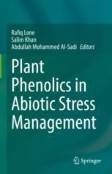Search
Search Results
-
Controlling of Xanthomonas axonopodis pv. phaseoli by induction of phenolic compounds in bean plants using salicylic and benzoic acids
This study deals with the potentiality of salicylic (SA) and benzoic (BA) acids for controlling the common blight of beans (CBB) caused by Xanthomonas...

-
Phenol Oxidation
Lignins are major structural components of plant cell walls and hence of plant litter. The complex polymer effectively resists chemical and enzymatic...
-
Physiological and transcriptomic analyses to reveal underlying phenolic acid action in consecutive monoculture problem of Polygonatum odoratum
BackgroundThe root rot of fragrant solomonseal ( Polygonatum odoratum ) has occurred frequently in the traditional P. odoratum cultivating areas in...

-
Phenolic compounds suppress anthracnose decay by enhancing antifungal properties and biochemical defence responses in avocado fruit
Avocados are economically important fruit, however, anthracnose caused by Colletotrichum gloeosporioides affects the fruit quality during marketing....

-
Overview on Structural and Functional Diversity of Secondary Metabolites
Secondary metabolites (SMs) are structurally classified into three main classes including (a) phenolic compoundsPhenolic compounds", (b) terpenes and...
-
Changes in phenolic acids, flavonoids, anthocyanins, and antioxidant activities of Mahonia aquifolium berries during fruit development and elucidation of the phenolic biosynthetic pathway
It is important to determine the most suitable ripening period of fruit regarding bioactive compounds for evaluating as an industrial and in human...

-
Enhanced somatic embryogenesis, plant regeneration and total phenolic content estimation in Lycium barbarum L.: a highly nutritive and medicinal plant
Lycium barbarum ( Solanaceae ), commonly known as Goji (or wolfberry), is popular for its nutritive and medicinal properties and is called a “super...

-
Profile and Biological Properties of the Main Phenolic Compounds in Cactus Pear (Opuntia spp.)
Natural plant-derived phenolic extract recently received much attention in the food industry to obtain bioactive compounds for food and...
-
The Effect of Salt Stress on Antimicrobial Activity and Potential Production of Anthocyanin and Total Phenolic of Salicornia in Hydroponic Culture
Plants are sources of a wide range of secondary metabolites. Secondary metabolites show a critical role in protecting plants against herbivores and...

-
Phenolic compounds as natural feed additives in poultry and swine diets: a review
Due to ban on using antibiotics in feed industry, awareness of using natural feed additives have led to a great demand. The interest of plants...
-
Effect of selenium biofortification on phenolic content and antioxidant properties of Jute leaf (Corchorus olitorius)
This study investigated the effect of selenium (Se) biofortification on the mineral composition, phenolic content and antioxidant properties of Jute...

-
Natural preservation and improving lipid oxidation inhibition of fresh walnut
Fresh walnut kernels (FWKs) are appreciated because of their unique flavor; however, maintenance of FWKs is still restricted because of their short...

-
Effects of roasting on the phenolic phytochemicals and antioxidant activities of pumpkin seed
Pumpkin seed ( Cucurbita pepo ) otherwise known as pepitas serves as food and has several medicinal uses in many parts of the world. This study...

-
Treatment of wood fibres with laccases: improved hardboard properties through phenolic oligomerization
Laccase-treated wood fibres were tested for small-scale wet-process manufacture of hardboards. Two laccases of distinct redox potentials, one from Pycn...

-
Characterization of carotenoids, chlorophylls, total phenolic compounds, and antioxidant activity of Brassica oleracea L var. botrytis leaves from Pakistan
Brassica oleracea L. var. botrytis leaves are commonly used leafy vegetables in Pakistan; however, there is a lack of literature regarding the...

-
Status of Phenolic Metabolism and Glutathione Detoxification Pathway in Waterlogged Maize as Affected by KNO3 Treatment
AbstractThe present study was undertaken to investigate the role of potassium nitrate in the modulation of phenolic metabolism and glutathione...

-
Stimulation of phenolic compounds accumulation and antioxidant activity in in vitro culture of Salvia tebesana Bunge in response to nano-TiO2 and methyl jasmonate elicitors
In the present study, we first attempted to achieve an efficient procedure for optimizing callogenesis from apical meristem and leaf explants of Salvia...

-
Plant Phenolics Production: A Strategy for Biotic Stress Management
Phenolic compounds (polyphenols/phenolics) are the plants’ secondary metabolites produced for defense purposes. The ubiquitous nature of phenolics...
-
Plants’ Fungal Diseases and Phenolics Response
Plants are susceptible to pathogens like fungi, which reduce plant survival and cause losses in yield and fruit quality. However, pathogens are...
-
Genetic Basis of Phenolics in Abiotic Stress Management
Phenolic compounds are the largest group of plant secondary metabolites. Plants synthesize phenolic compounds utilizing precursor via shikimic...
